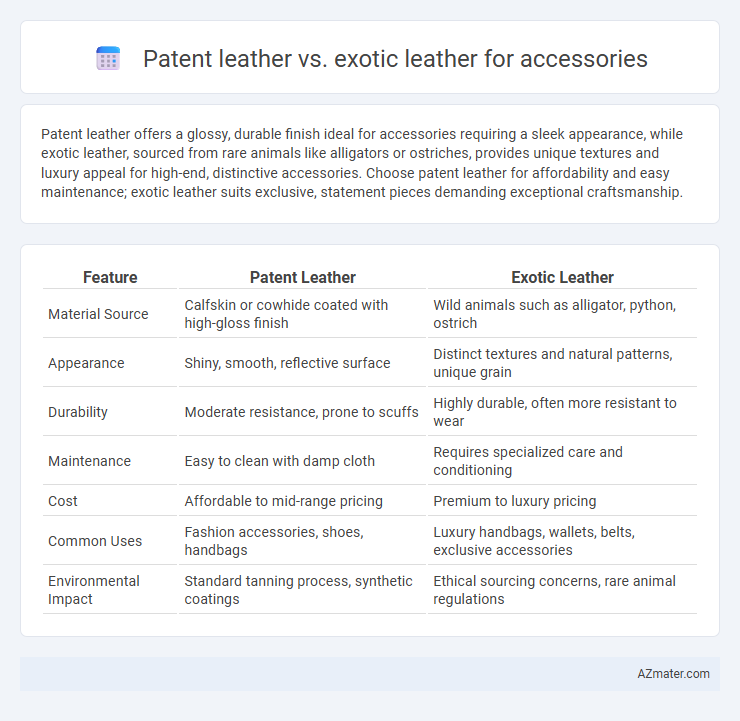Patent leather offers a glossy, durable finish ideal for accessories requiring a sleek appearance, while exotic leather, sourced from rare animals like alligators or ostriches, provides unique textures and luxury appeal for high-end, distinctive accessories. Choose patent leather for affordability and easy maintenance; exotic leather suits exclusive, statement pieces demanding exceptional craftsmanship.
Table of Comparison
| Feature | Patent Leather | Exotic Leather |
|---|---|---|
| Material Source | Calfskin or cowhide coated with high-gloss finish | Wild animals such as alligator, python, ostrich |
| Appearance | Shiny, smooth, reflective surface | Distinct textures and natural patterns, unique grain |
| Durability | Moderate resistance, prone to scuffs | Highly durable, often more resistant to wear |
| Maintenance | Easy to clean with damp cloth | Requires specialized care and conditioning |
| Cost | Affordable to mid-range pricing | Premium to luxury pricing |
| Common Uses | Fashion accessories, shoes, handbags | Luxury handbags, wallets, belts, exclusive accessories |
| Environmental Impact | Standard tanning process, synthetic coatings | Ethical sourcing concerns, rare animal regulations |
Introduction: Patent Leather vs Exotic Leather
Patent leather features a glossy, smooth finish achieved through a coating process, making it a popular choice for sleek and modern accessories. Exotic leather, derived from unique animal skins such as crocodile, ostrich, or snake, offers distinctive textures and patterns prized for luxury and exclusivity. Both materials provide different aesthetic and tactile experiences, influencing the design and prestige of fashion accessories.
Defining Patent Leather
Patent leather is a type of coated leather characterized by its glossy, high-shine finish achieved through a plastic or lacquer coating, making it highly resistant to water and stains. Unlike exotic leather, which is crafted from unique animal skins such as alligator, ostrich, or python with distinct textures and natural patterns, patent leather offers a smooth, uniform surface ideal for sleek accessory designs. Its durability and polished appearance make patent leather a popular choice for accessories needing both style and practicality.
Understanding Exotic Leather Types
Exotic leather types commonly used for accessories include alligator, ostrich, python, and stingray, each offering unique textures and durability properties that surpass the high-gloss finish of patent leather. Unlike patent leather, which is typically cowhide coated with a glossy finish, exotic leathers provide natural patterns and are prized for their rarity and luxury appeal. Knowledge of the specific animal origin and tanning process is crucial for identifying quality, ethical sourcing, and optimal care of exotic leather accessories.
Key Aesthetic Differences
Patent leather features a high-gloss, reflective surface created through a coating process, offering a sleek and polished appearance ideal for modern accessories. Exotic leather, sourced from animals like alligators, snakes, or ostriches, showcases unique textures and natural patterns, adding an element of luxury and individuality to products. The key aesthetic difference lies in patent leather's uniform shine versus exotic leather's distinctive, tactile grain that enhances the visual and tactile appeal of accessories.
Durability and Wear Resistance
Patent leather boasts a smooth, glossy finish achieved through a lacquer coating that enhances its wear resistance and protects against water and stains, making it highly durable for accessories. Exotic leather, derived from unique animal skins such as alligator, ostrich, or snake, offers natural texture and strength but may require specialized care to maintain its durability over time. Both materials provide longevity, but patent leather typically excels in resisting surface damage, while exotic leather offers superior flexibility and distinctive aesthetic appeal.
Maintenance and Care Requirements
Patent leather requires regular wiping with a damp cloth and occasional use of a leather conditioner to maintain its glossy finish and prevent cracking. Exotic leather, such as alligator or ostrich, demands specialized care using gentle leather cleaners and moisturizers designed specifically for delicate textures to avoid drying and damage. Both types benefit from storage in a cool, dry place away from direct sunlight to preserve their appearance and durability.
Price and Market Value
Patent leather, known for its glossy finish and affordability, typically costs less than exotic leathers such as alligator, ostrich, or python, which command premium prices due to rarity and craftsmanship. Exotic leather accessories hold higher market value, reflecting their exclusivity, durability, and status symbol appeal in luxury fashion markets. Buyers often weigh patent leather's cost-effectiveness against exotic leather's elevated resale potential and investment worth.
Ethical and Environmental Considerations
Patent leather, known for its glossy finish, is typically derived from cowhide and undergoes chemical treatments that raise concerns about environmental pollution due to toxic waste disposal. Exotic leathers such as alligator, python, and ostrich are sourced from wild or farmed animals, prompting ethical debates regarding wildlife conservation and animal welfare regulations. Choosing accessories made from eco-friendly alternatives or certified sustainable exotic leather supports reduced ecological footprints and promotes responsible fashion consumption.
Popular Uses in Accessories
Patent leather is widely favored for accessories like handbags, wallets, and shoes due to its glossy finish and water-resistant properties, which enhance durability and style. Exotic leathers, sourced from materials such as alligator, snake, and ostrich, are popular for luxury accessories including belts, watch straps, and high-end handbags, offering unique textures and exclusivity. Both materials cater to different market segments, with patent leather appealing to fashion-conscious consumers seeking sleek, affordable options, while exotic leather targets luxury buyers valuing rarity and craftsmanship.
Choosing the Right Leather for Your Style
Patent leather offers a glossy, polished finish ideal for sleek and modern accessory designs, making it a perfect choice for formal occasions and bold fashion statements. Exotic leathers like crocodile, ostrich, and snakeskin provide unique textures and patterns that add luxury and individuality to accessories, appealing to those seeking distinctive and high-end style. Selecting the right leather depends on your desired aesthetic: patent leather suits a contemporary, sophisticated look, while exotic leather enhances exclusivity and tactile richness in your accessories.

Infographic: Patent leather vs Exotic leather for Accessory
 azmater.com
azmater.com